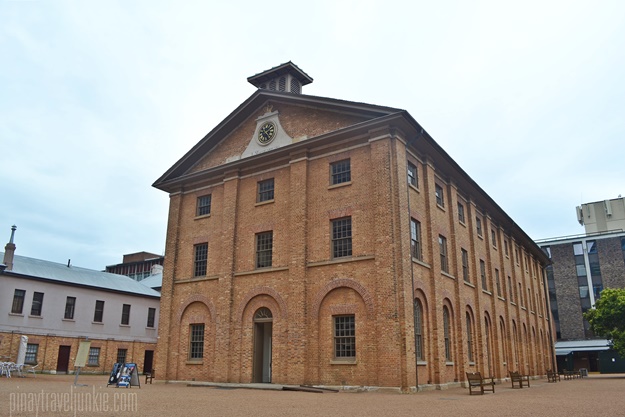
The spring sky was shrouded by dim gray clouds. Imposing a mean threat. I huffed a fog as I quickened my pace and barked at the rest to hustle like so. Brisk, short steps. I knew that when it rains, there’s no way my measly knit top-mini shorts-opaque tights ensemble could shield me from the cold. The others behind my trail, though clothed in thicker layers, must have thought the same for they too sped up.
Travel blogger Ron of Flip Travels, my sister, her friend from Singapore and I had just emerged from Sydney’s Town Hall Station a couple of minutes earlier. Everyone’s mood was as sullen as the weather but our eyes were set on UNESCO World Heritage Site Hyde Barracks Museum. We already gave up Sydney Opera House that arvo, and we sure didn’t want to surrender the museum to the impending rain as well (because we’ll prolly end up wasting money on cheeseboards and mason jars at the nearest Kmart).
We weaved through Sydney central business district’s foot traffic and breezed by the annual pop-up hawker market, Night Noodle Market (merchants of which were still setting up their booths) at Hyde Park. We also burned some precious minutes obsessing over/mimicking Theseus and the Minotaur of Archibald Fountain (to the amusement of passersby) — because we couldn’t help it — before we strode the last two hundred meters to the museum.
I did Minotaur while Ron did Theseus. In case you’re wondering.
The museum’s courtyard was deserted when we arrived. In the stillness and morosity, the main building was looking rather sinister. And for some random reason, I imagined it being a Walking Dead filming location. The Hyde Barracks building was designed by English-born architect Francis Howard Greenway (who was sentenced to penal transportation after pleading guilty to forgery) and was constructed entirely by convict labor. It served as accommodation for convicts in Sydney until its closure in 1848. It was also used as a female immigration depot and later on a government-run asylum for destitute women. After years of disrepair, it was renovated and turned into a museum.
Admission’s an affordable $10 for adults and $5 for children (or pay $18 for the Sydney Museums Pass to get access to three other museums). Comes with a brilliant audio guide. After swiftly perusing knick-knacks, souvenirs and books (and they do have interesting books) at the gift shop, we all submitted to our respective guides and disappeared in our own worlds.
Tour commences on the ground floor of the three-storey building just across the reception. The clever storytelling begins with the arrival of convicts from various countries, illustrated by a map entitled “Human Cargo”. Artifacts (a few showcasing taxidermy for added oomph) and paintings give visitors a glimpse of what a convict’s life was like. The “Tool Wall”, as the name says, showcases tools which the convicts used to build the city.
Before ascending the steps to the second and third floor, the audio guide instructs one to look up the ceiling and see the structure’s exposed original beams. On the walls are writings of convicts who worked on them. Up the stairs, the audio guide then tells the story about the barracks being used as an immigration depot for female immigrants and as an asylum. In one of the rooms, I opened chests containing brief bios of selected female immigrants. In another room, where male convicts slumbered, I lied down a replicate hammock.
And in another, dropped my SLR. Had a crack on the filter but still worked. In case you’re wondering.
It was one dreamy, trippy tour. The audio guide’s narration paired with artifacts and a few interactive displays make for a fantastic presentation. Add to that the glum weather outside, our visit had a somewhat serious, somber vibe. In the last room, as the audio guide’s narrator ended the tour, in my head was a standing ovation. I would have given it a real one had I not been already on my feet. And well, the applause would have freaked people out. Needless to say, this museum buff was very impressed.
Outside, the rain started pouring. It was to be a wet, twenty-minute walk back to the hostel. But after all those stories of hard labor in harsh conditions, that stroll of ours seemed like a walk in the park.
Hyde Park Barracks Museum
Macquarie Street, Queens Square,
Sydney CBD, New South Wales, Australia

In typical Aussie style, Greenway appeared on the $10 note.A fitting tribute to a convict architect/forger.
Haha! YES!
nakakahiyang hindi pa ako nakapunta dto 😀 gandang photoshoot venue yeah?
Sa pagkakaalam ko, si Marv di rin pa nakakapunta. Lol. So you’re good ;-p
amazing stories Gay! If your readers would need assistance in touring Australia. Our company Tripovo is more than willing to help them.